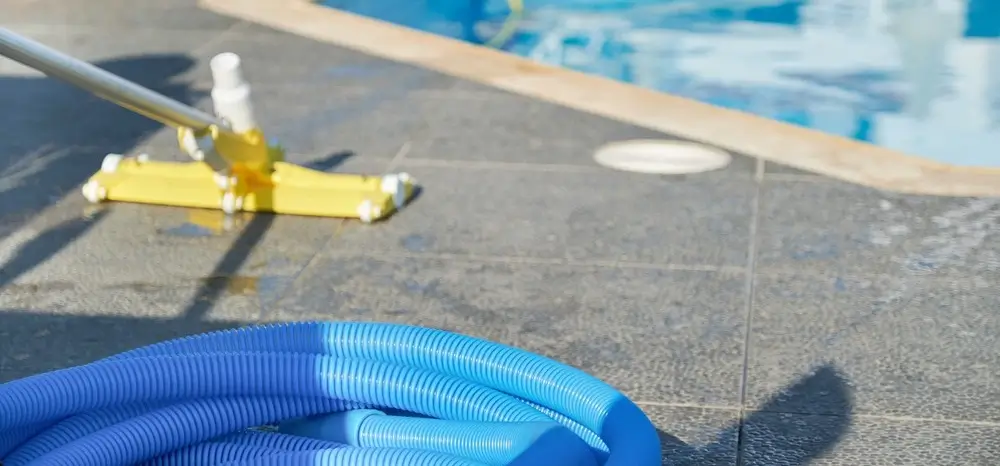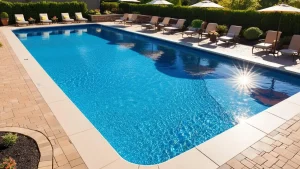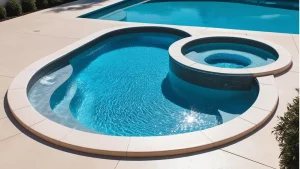Selecting the best fiberglass pool vacuum brings a wealth of benefits to your cleaning routine. For owners craving spotless surfaces, these vacuums are essential tools that simplify maintenance while ensuring pristine waterside leisure time. With various models spanning corded and cordless designs, pinpointing an ideal match might seem tricky – but fear not!
Certain features stand out as critical for optimal performance in fiberglass pools. This guide focuses on identifying those key traits, letting potential buyers cut through confusion with ease. Moreover, beyond just choosing correctly comes the commitment to ongoing care; understanding what makes or breaks success here is vital for long-term satisfaction.
Why a Fiberglass Pool Vacuum is a Must-Have
A vitreous pool vacuum is an important tool for maintaining a clean swimming pool. Here’s why securing one is critical:
- Pool-specific needs play a pivotal role in selecting the right vacuum. For pools with sleek surfaces, like fiberglass, choose a model armed with soft PVA brushes to prevent scratching and ensure efficient cleaning.
- Correct sizing matches your pool layout to the necessary equipment range. Ensure your chosen robotic cleaner has ample cable length; otherwise, you’ll be hindered by its reach limitations as if using a household vacuum tethered by a short cord.
- Cleaner efficiency relates directly to required maintenance tasks. Identify which areas of your pool demand attention and opt for models proficient in those aspects—floor only or comprehensive vertical wall-to-water line coverage—for maximum effectiveness without wasting resources on unnecessary features.
Key Benefit of Using a Fiberglass Pool Vacuum
- Enhanced Cleanliness: A vacuum cleaner for fiberglass pools will keep your pool clean by sucking dirt and litter in it. It can access tough corners, ensuring comprehensive coverage without manual intervention. The device significantly reduces the time spent on cleaning as it operates automatically, allowing for more leisure time instead of maintenance tasks.
- Protection for Pool Surfaces: Safeguarding the gel coat is crucial in maintaining a fiberglass pool’s integrity and appearance; vacuums offer non-abrasive cleaning that will not harm this protective layer. Regular use prevents buildup, which could lead to staining or damage to the gelcoat over time—a key factor in extending your pool’s lifespan.
- Efficient Maintenance Routine: Integrating an automatic vacuum into your pool care routine enhances efficiency drastically, working independently from other systems like pumps or filters—it has its filtration mechanism for convenience and effectiveness while saving energy costs associated with extensive pump usage during manual cleanings.
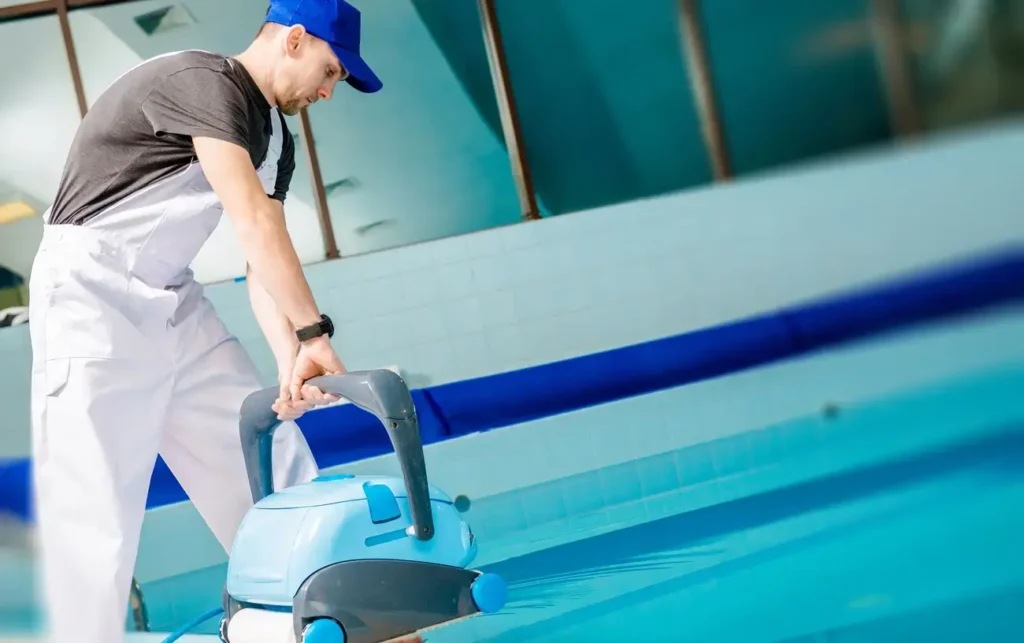
Types of Pool Vacuums Suitable for Fiberglass Pools
For optimal care of fiberglass pools, consumers have several vacuum options. Automatic robotic cleaners are a popular choice due to their efficiency and advanced features like remote control and self-cleaning; they range from $400 to $1500 in price. Basic models suit small pools, while larger units with wall-climbing capabilities serve big pools better.
A more budget-friendly method involves using brushes and skimmers, which demand manual work but effectively clear algae and debris. This approach may increase the workload for pool filters. Manual vacuums represent an intermediate solution offering targeted cleaning by linking a hand-held device to the filtration system via hose – it’s advisable after brushing the sides of your pool first.
High-end setups might feature built-in floor vacuums that integrate seamlessly into the pool structure, activating on-demand for effortless maintenance, though they do require regular filter attention. Keeping your pool clean prevents illnesses and ensures water clarity. It offsets rapid contaminant buildup from frequent use, environmental factors, body oils, chemical mismanagement, or natural elements.
Factors to Consider When Choosing a Fiberglass Pool Vacuum
- Durability of Materials: Sturdy materials extend a fiberglass pool vacuum head’s lifespan and improve cost-effectiveness. Select ones crafted from high-quality, chemical-resistant plastics or metals to ensure longevity despite frequent exposure to harsh pool chemicals and the sun’s UV rays. Halting premature wear ensures uninterrupted cleaning performance throughout many seasons.
- Vacuum Head Design: A well-designed vacuum head delivers enhanced efficiency in various parts of your fiberglass pool by accommodating its specific shape and size requirements; select between weighted heads for flat areas and flexible models that contour to surfaces snugly are worth considering, while specialized corner designs reach difficult nooks with ease.
- Suction Power Connection: Ensure compatibility among the skimmer system, pump model, and hose length, guaranteeing optimal suction power vital for thorough debris removal; opting for a leak-free hose is imperative as it forms an essential conduit between the cleaning device and filtration equipment, enabling effective dirt extraction without pressure issues affecting overall functionality.
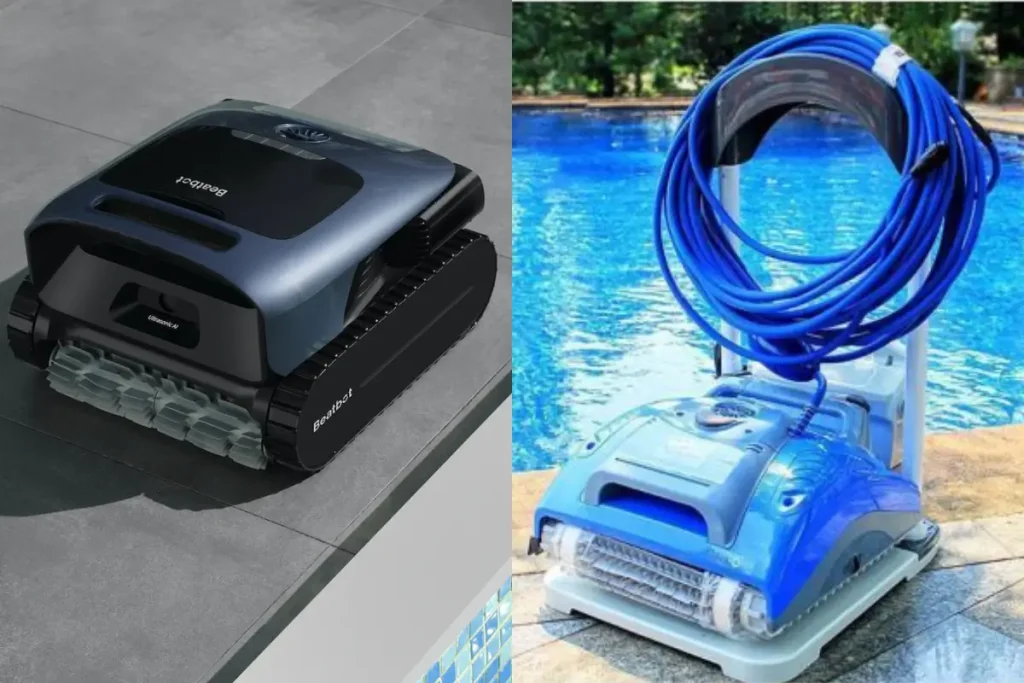
Corded vs. Cordless Pool Vacuums: Which One is Better?
When analyzing corded and cordless pool vacuums, it’s clear each has distinct benefits. Cordless models offer significant mobility and simplicity. With no cords to manage, they’re a breeze for cleaning small pools or tight spaces.
Lightweight designs make them easy to handle and store – perfect when space is at a premium. Corded vacuums shine in continuous power delivery, which is necessary for longer clean-ups of larger pools with heavy debris loads. Their potent suction can tackle substantial piles of leaves efficiently.
For expansive areas requiring consistent strong suction without the interruption of recharging batteries, corded units excel. While robot cleaners like Beatbot AquaSense provide smart technology integration and low maintenance advantages by merging features of both types, your pool size and convenience preferences should guide your choice between a traditional corded or modern cordless vacuum solution.
Top Features to Look for in a Fiberglass Pool Vacuum
When choosing a fiberglass pool vacuum, the type of vacuum head is crucial for thorough cleaning. A compatible and efficient head ensures pools remain clear and free from debris.
- Telescopic poles are indispensable as they offer adjustable lengths to reach every corner of your pool effortlessly. Whether you need to clean the deep end or skim debris off the surface with a net, these poles prove essential.
- The quality and compatibility of your vacuum hose determine its effectiveness in connecting with both the pump and skimmer outlet. An excellent hose should be leak-proof to ensure maximum suction power for optimal cleaning results without fail.
- Lastly, consider brushes that pair well with your chosen head; their bristles must strike a balance between tough on algae yet gentle enough not to scratch delicate surfaces. Different brush types cater to varying levels of scrubbing capability, enhancing overall maintenance efforts.
Each feature plays an integral role when maintaining pristine swimming conditions while also preserving the integrity of fiberglass finishes.
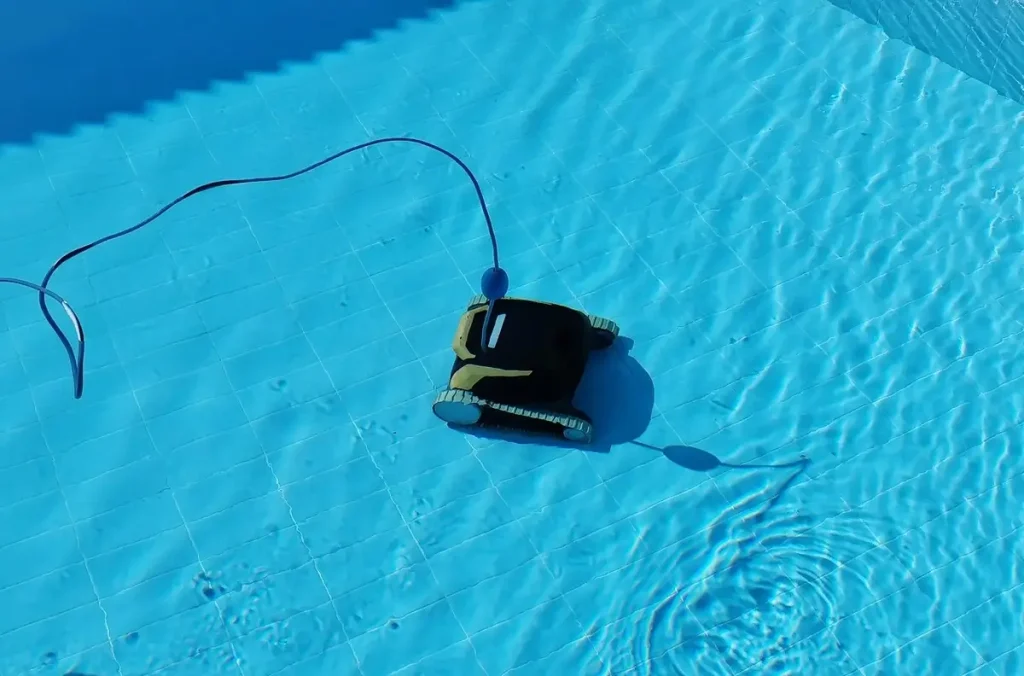
Best Practices for Maintaining Your Fiberglass Pool Vacuum
To ensure your fiberglass pool stays spotless, start with surface skimming to remove leaves and debris. This prevents clogs in the vacuum system. For an immaculate waterline free of contaminants like lotion or oil, gently scrub using a soft-bristled brush for fiberglass surfaces.
This helps keep algae from building up and keeps your pond looking good. Regular vacuuming is essential; it Removes settled dirt. An automatic cleaner can simplify maintenance while boosting efficiency.
Verify chlorine levels often to fend off bacteria without irritating swimmers’ skin or eyes. A saltwater chlorinator simplifies this process but necessitates routine cleaning, too. A correctly sized filtration unit – sand, cartridge, or DE filter – is crucial as well.
Clean filters regularly following manufacturer guidelines will preserve water clarity and hygiene standards. Inspect equipment periodically for longevity. Be proactive in repairing any damage before small issues escalate into costly repairs.
Common Mistakes to Avoid When Selecting a Pool Vacuum
Selecting the right pool vacuum for a fiberglass surface involves thoughtful consideration to avoid common pitfalls. Here’s what should be on every buyer’s radar
- Oversimplifying maintenance can lead to green, unusable pools. Delayed cleaning escalates dirt and grime buildup, making restoration tough. Fiberglass surfaces require regular attention; hence, choosing an efficient fiberglass pool vacuum is vital.
- Pool chemicals are crucial but not comprehensive cleaners. They sanitize but don’t remove oils, lotions or debris that filters miss — highlighting the necessity of proper equipment like vacuums tailored for finer particulate removal pertinent in maintaining pristine water conditions.
- Inadequate brushes compromise efficiency and potentially damage delicate fiberglass finishes. Buyers need vacuums with compatible attachments – soft nylon bristles are ideal – preventing scratches while ensuring algae and residue-free cleanliness essential for sparkling swimming environments.
Focusing on these specifics ensures selection accuracy when investing in suitable pool care tools.
Summary: Choosing the Perfect Fiberglass Pool Vacuum Made Simple
Fiberglass pool vacuums are a must-have for keeping your pool clean and protecting its surface. They clean efficiently and help prevent damage to the pool’s delicate gel coating. You can choose between robotic vacuums for hands-free cleaning or manual ones for better control. There are also corded and cordless options to fit your needs. Look for durable materials, strong suction power, and the right vacuum head for the best results.
To keep your pool in great shape, skim debris off the surface often, brush gently to avoid algae, and use a good filtration system. Don’t rely only on chemicals or use rough brushes that can damage the pool. Consistent care and the right tools will keep your pool clean and looking great with less effort.
Frequently Asked Question
What is the best type of vacuum for fiberglass pools?
The best vacuum for fiberglass pools is a robotic model with soft PVA brushes or a manual vacuum with non-abrasive attachments. These ensure a thorough clean without damaging the gel coat surface.
How often can I vacuum my fiberglass pool?
Vacuum your fiberglass pool weekly to remove dirt and grime. Used daily, it keeps you looking nice and clean without much effort.
Can I use a normal pool vacuum for my fiberglass pool?
According to that, the best thing is to only use a vacuum made for fiberglass pools, as such a product will cause no harm at all to the gel coat. Regular application of a soft brush can damage the sensitive area.
What is the difference between cordless and cordless pool vacuums for glassware pools?
Corded vacuums give you constant power, making them great for a large pool. Portable and ideal for small pools, cordless models work. You choose based on your pool maintenance needs.
How do I service a fiberglass pool vacuum?
The maintenance routine for your vacuum should include brushing, housing and washing its filters in addition to checking them for damaged parts. The brush must be soft enough not to cause scratches on the surface of the fiberglass.

